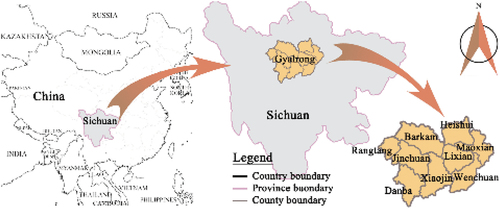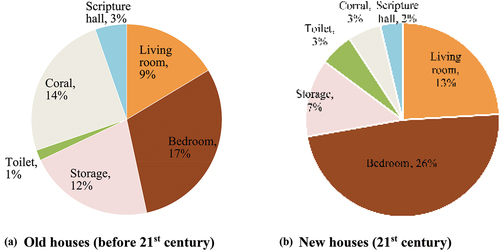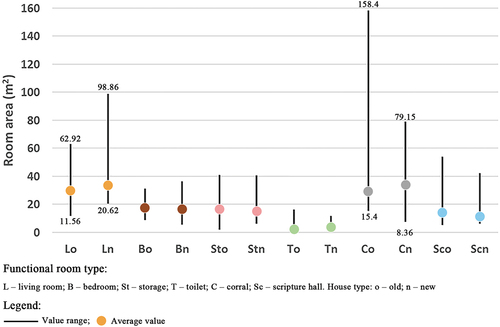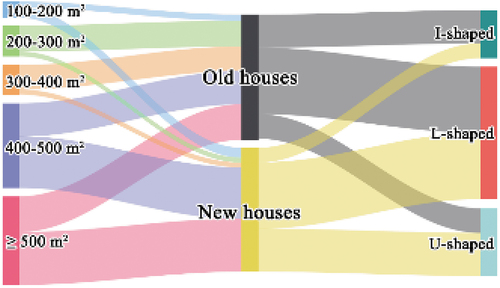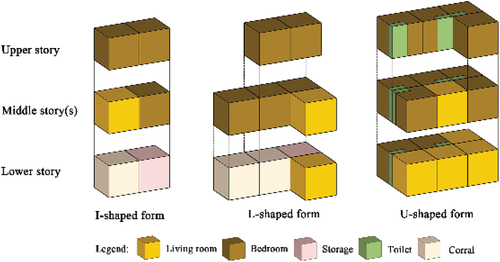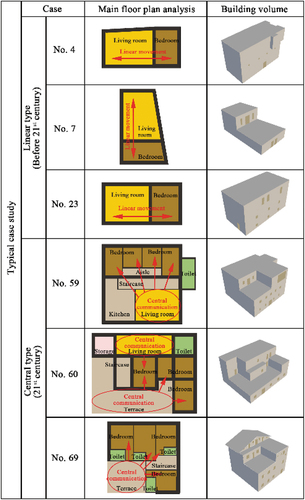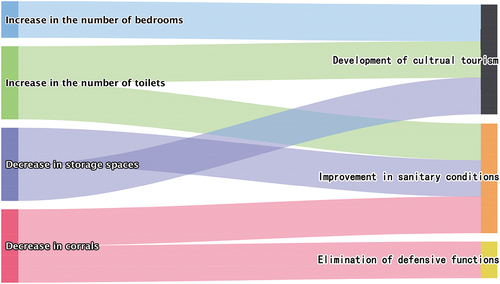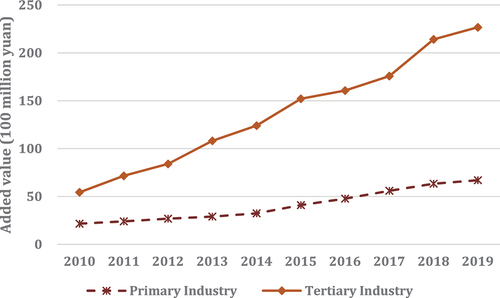ABSTRACT
The Qinghai-Tibet Plateau has many traditional dwellings that are suitable for research into architectural design. However, the current state of research on vernacular Tibetan houses is still limited by study regions, sample sizes, and historical perspective. By selecting 82 folk houses in the Gyalrong Tibetan area as study objects, this work aims to (1) record a fading tradition of vernacular architecture assisted by computer modelling and mathematical statistics; (2) analyse the historical evolution of the functional organization of the houses; and (3) explore the reasons for this evolution to give suggestions to contemporary architectural designers. The investigation reveals that (1) the evolution of the functional organization between old and new houses primarily includes an increase in the number of bedrooms and toilets and a decrease in the area of storage spaces and corrals and (2) the historical reasons for this evolution include changing concerns about defence, sanitation, and the tourism industry. Finally, suggestions for future house design are given in terms of the arrangement of building volume, the arrangement of central communication spaces, and the separation of spaces for landlords and guests.
GRAPHICAL ABSTRACT
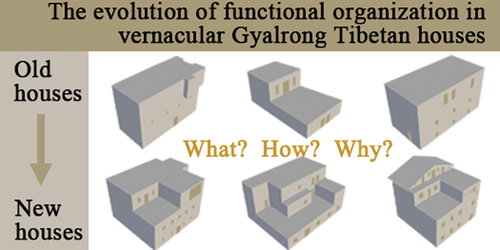
1. Introduction
Vernacular or regional architecture, with its symbolic value and rich artistic embellishments (Kempenaar and van den Brink Citation2018), is one measure of the quality of the craftsmanship within a society, making it a good object for research into architectural design (Luck Citation2019). Tibetan dwellings portray many aspects of Tibetan society and reflect the variety of influences that have affected the culture over time, particularly Buddhism (Semple Citation2005). As one of the Tibetan areas outside the Tibet Autonomous Region of China, Gyalrong, in Sichuan Province, features Tibetan dwellings with strong regional characteristics that have been adapted to the natural environment and cultural traditions. However, in the context of rapid social changes, traditional Tibetan dwellings are undergoing profound alterations, which are reflected in their functional use of space and other design aspects. Amid spontaneous transformations, the development of modern Tibetan dwellings has been driven by contemporary issues.
Previous studies of Tibetan buildings have mainly focused on investigations of settlements, traditional building technologies, and Tibetan architectural design. First, Tibetan settlements are the outcome of unique natural and manmade ecology (Mao Citation2019). Scholars have conducted field investigations in typical villages of Tibetan groups (Xiang et al. Citation2017). Research on folk houses in these settlements mainly addresses their decorations (Huang and Yuan Citation2010), fire pits (Lang and Kangbu Tsongkha Citation2020), and construction techniques (Tang Citation2016).
Second, traditional technologies special to Tibetan buildings mainly refer to their passive solar features (Ding Citation2022; Z. Liu et al. Citation2019; Wang et al. Citation2017). In Tibet, solar radiation, rather than altitude, is a key factor in calculating energy consumption and determining energy conservation design strategies (D. Liu et al. Citation2016). Some construction parameters, such as the correction factor for the heat transfer coefficient of a building envelope, are quite different from those in other cities with similar average outdoor temperatures during the cold season (Zhu et al. Citation2008). Additionally, many studies have focused on the energy performance of Tibetan buildings. While Tibetan dwellings that are designed take into account the abundant solar energy and the lack of fossil fuels are very well adapted to local climate conditions (Nie et al. Citation2019), Tibet’s residential development still lags behind other regions (Ma, Zhou, and Liu Citation2011). In addition to research on building technology, there has been research into Tibetan architectural design. The key to vernacular building in Tibet is working with the local environment, through which passive and sustainable solutions can be redeveloped for modern use (Huang and Yuan Citation2010).
Third, these previous studies also provide insight into contemporary Tibetan architectural design, especially of public landmarks. For example, the Administrative Centre of Yushu in the Tibetan Autonomous Prefecture constructed in 2014, simultaneously presented symbolic connection with power and connotations of openness and goodwill via grand architectural profiles on the building shapes and approachable courtyards with Tibetan characteristics (Zhuang, Zhang, and Qu Citation2015).
However, the extant literature is insufficient for the following reasons: First, these studies have mainly focused on the political and religious centre of Lhasa, which is in the plateau pasture region (Huang et al. Citation2016; Zhang and Lian Citation2015; Huang and Kang Citation2021), rather than on the alpine gorge regions located at the edge of the Tibetan Plateau. Second, previous research has often been limited to a small number of representative buildings; there have been no quantitative studies of extensive amounts of vernacular architecture. Third, although the spatial functions of traditional Tibetan buildings have been studied, there are no scientific analyses of the historical evolution of these functions.
The goal of this work is to (1) record fading architectural traditions with computer modelling and mathematical statistics; (2) analyse the historical evolution of the functional organization of minority houses; and (3) explore the reasons for the evolution in organization to provide suggestions for contemporary architectural design. To analyse the rationality and practicality of the spatial functions of vernacular buildings in the alpine gorge regions of the Tibetan Plateau, this paper presents a study of folk houses in the Gyalrong Tibetan area, involving three phases of analysis. First, 82 vernacular Gyalrong Tibetan blockhouses constructed between the 14th century and the modern era are assessed through a literature review, expert interviews, and field investigations. Second, the architectural functions of these buildings are analysed in terms of the distribution of functional rooms, the area of main rooms, and the prototype for functional organization. Third, the present work discusses the reasons for the above historical development, which include the elimination of defensive functions, the improvement in sanitary conditions, and the development of cultural tourism.
2. Materials and methods
2.1. Research region
Gyalrong is located entirely within the territory of the Aba Tibetan and Qiang Autonomous Region in Sichuan Province (Hongtao Citation2012) () and not in the Tibet Autonomous Region, China. The word “Gyalrong” is a transliteration of a “warm valley farming area” in the Tibetan language. It is a cultural and geographical name that has evolved over time (Mao Citation2019).
The geography, climate, economy, ethnicity, and population of Gyalrong are unique. Geographically, the ecology of the Gyalrong area is fragile. Its three-dimensional ecological footprint is typical of alpine and canyon areas, leading to agricultural production. Solar energy is abundant, as the annual radiation is generally higher than 5000 MJ/m2 (Binbin and Cheng Citation2014). On the other hand, Gyalrong has a historical, cultural, and social atmosphere that facilitates multiethnic communication and integration; it is a place where minorities (mostly Tibetan and Qiang nationalities) have lived together since antiquity. However, constrained by geographical space, the economic conditions of the Gyalrong area are poor (Zheng, Zhong, and Liao Citation2016).
2.2. Case studies
In the Gyalrong area, the majority of houses are stone blockhouses () (Chen Citation2012). According to weight-bearing structures, blockhouses are divided into categories comprising a wooden frame bearing type, a wall bearing type, and a wall-column-hybrid bearing type. As the basic living unit for Tibetan people in Gyalrong, the shapes and functions of different blockhouses are similar (Ryser Citation2013). The typical layout of the blockhouses is square, simple, and compact. Their plan layouts are shaped mainly into I-shaped, L-shaped, and U-shaped forms. Their vertical designs are usually symmetrical and uniform, conforming to seismic building design principles.
To study the adaptive evolution of the functional organization of Gyalrong houses, this study selected 82 Tibetan blockhouses built between the 14th century and 2015 as case studies. These cases include 56 structures built before the 21st century (henceforth, old houses) and 26 in the new century (new houses). For centuries, Tibetan communities have commonly adopted a construction method called “craftsmen exchange”Footnote1 (Wenyong, Hua, and Wang Citation2017), which is a traditional participatory design and construction method (Luck Citation2018). Thus, the case studies included here can be generalized to the overall situation of Gyalrong Tibetan blockhouses. In addition, these cases consist of only the main buildings in Tibetan courtyards, excluding any auxiliary buildings that may exist on the same property.
2.3. Computer-aided investigation
This research used computer-aided methods in a quantitative investigation, as shown in . (A) The case study data were collected via a literature review, field investigations, and expert interviews. For most of the case studies, construction data were obtained from previously published works; for other cases, manual measurements and drawings were conducted one by one on site; and for some cases with ambiguous spaces or constructions, the author conducted expert interviews with local workers to obtain more explicit plans. (B) The plans of the selected cases were drawn in BECS software, a fundamental application of Green Building Software widely used in China GBSware Citation2022), an energy-saving building design software based on CAD platform. To focus on the functional organization of Gyalrong houses, this work primarily presents room types, values of wall width and height, roof forms, and main openings for each of the case studies, overlooking other building components and parameters. (C) Data visualization was achieved with 3D- models of the cases generated automatically (Zouaoui, Djebri, and Capsoni Citation2021; Das and Garg Citation2011).Footnote2 (D) The original data (e.g., building area, shape coefficients, proportions of different kinds of rooms) were extracted automatically from the software. These data are shown in the APPENDICES. Then, the general characteristics of the cases were obtained (), and the data regarding functional organization were analysed and compared. In short, the advantage of adopting this computer-aided method is the convenient conversion from 2D- drawings to 3D- models and the ease with which we can extract data.
Figure 3. Computer-aided process based on the BECS software (e.g., case no. 21(C. Liu Citation2005)).
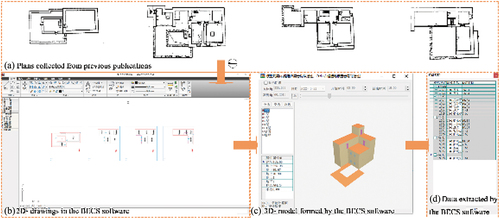
3. Quantitative data analyses
This section analyses the functional organization of Gyalrong blockhouses based on the following aspects: the distribution of functional rooms, the area of the main rooms, and the prototypical design of functional organization.
3.1. The distribution of functional rooms
The distribution of functional rooms in both the old and new houses has points of commonality and difference (). The case buildings range between 1 and 9 floors, with an average of 3.66 floors. Among them, the old houses have an average of 3.73 floors, and the new ones have an average of 3.50 floors. The average area of all case studies is 451 m2, with 439 m2 and 475 m2 being the average areas for the old and new houses, respectively.
Table 1. Functional rooms and their distributions on different floors.
In terms of common points, first, the primary types of functional rooms in Gyalrong Tibetan houses are living rooms, bedrooms, storage areas, toilets, corrals, and scripture halls. Some examples also contain a porch, a kitchen, or other spaces. Among room types, bedrooms account for the largest number of functional rooms. Second, corrals are usually on the first floor, except for case study No. 37 (see APPENDICES), which has the corral on the second floor due to its special location on a slope, with entrances for livestock on both the first and second floors. Third, scripture halls are usually on the top floor, with a few exceptions where the top floors of the blockhouses are used for crop storage or drying, and scripture halls are located on the subtop floor instead.
In terms of differences, first, from old houses to new houses, the average number of living rooms in a single Tibetan dwelling increased from 1.21 to 1.77 (). Second, the average number of bedrooms increased from 4.14 to 7.50. Third, the storage space area was sharply reduced and more evenly distributed across each floor. Fourth, the average number of toilets increased from 1.13 to 4.54, reflecting not only the relocation of toilets from auxiliary structures to main buildings but also the increase in the number of bedroom suites with toilets in the new residences. Fifth, while in the new houses, animal spaces are often absent, in the old houses the space on the lowest floor is usually corrals; only the upper floor or floors are human spaces and spiritual spaces. In most of the new houses, a corral is often absent – the entire building is a human space. Human spaces (mostly bedrooms and living rooms) are distributed from top to bottom in the new houses.
3.2. The area of the main rooms
Apart from the change in the number of different functional rooms, the proportions of functional spaces also evolved from old houses to new houses (). For example, the proportion of bedrooms and toilets increased, while that of storage and corrals decreased.
The area of each room has also changed, especially for living rooms and corrals (). First, the area of each living room greatly increased in the new houses. In the past, the living room was a space for gathering the family and warming up, and it typically had a low ceiling height with a stove in the middle and several cupboards along the walls. In recent Gyalrong blockhouses, living rooms are used for entertaining guests and travellers, and thus are often larger and brighter spaces with a large carpet in the middle and many sofas around it. Second, in Gyalrong Tibetan houses, the most common type of room is the bedroom. The area of each bedroom ranges from 5.65 m2 to 36.26 m2; however, the average area is similar for both old and new cases (approximately 17 m2). Third, the average area of each storage and scripture space barely changed. Fourth, the range of square area dedicated to the toilet narrowed from old (1.04 m2 – 16.23 m2) to new (1.96 m2 – 11.84 m2) houses. However, the average area of the toilet increased from 2.38 m2 to 3.57 m2. Fifth, the size of the corrals decreased sharply.
3.3. The prototypical of functional organization of a Gyalrong Tibetan house
The prototype of functional organization is based on the study in Section 3.1. In this subsection, we focus on the general form of the buildings rather than specific room functions or areas. To analyse the prototypical functional organization of a Gyalrong Tibetan house, selected case studies are categorized as shown in . The analysis shows that in old houses, the building areas range between 100 m2 and 500 m2 and in new houses, it is larger than 400 m2. The figure also shows that the I-shape form is more frequent in old houses, the U-shape form is more commonly seen in new houses, and the L-shape form is adopted equally frequently in both old and new houses.
As shown in , the organization is relatively simple in I-shaped houses: each space is basically the apposition of two functional spaces; the spatial connection is often linear. L-shaped houses are usually an outgrowth of I-shaped ones, which often reflect the household’s better economic conditions, providing a central communication space for the family. Last, U-shaped houses often have a central spatial connection and have more spaces dedicated to communication and gathering, and distributed throughout the house and taking many forms: large living rooms on the lower floor, small living rooms at the core of the middle floor or floors, and terraces provided by a floor retreat on the upper floor. While the linear spatial connection of I-shaped houses is suitable for a single family with a close relationship, the central connection space in U-shaped houses enables the house to be divided into public and private areas, making new houses suitable for multiple cohabitating families.
shows some typical cases of linear-type and central-type blockhouses built before the 21st century and in the 21st century, respectively. The main floors in refer to the most important living floor of each house, which presents the area with the highest daily resident traffics. In the old houses, plan layouts are simple, and the activity routes are linear. Simple routes result in cuboid building volumes with limited variation. In the new houses, every layout has one or more central spaces (living rooms and terraces). The activity routes radiate outwards from the centres to the bedrooms. The plan layouts are diverse and flexible, leading to varied building volumes.
4. Historical reasons for the evolution
According to the results in the previous section, the evolution of patterns in functional organization from old to new houses primarily includes an increase in the number of bedrooms and toilets and a decrease in the area of storage spaces and corrals. Thus, this section mainly discusses the historical reasons for this evolution, which include the elimination of defensive functions, the improvement in sanitary conditions, and the development of cultural tourism ().
The formation of this kind of architecture is related not only to the natural environment but also to the social environment. As the main type of Gyalrong dwellings, stone blockhouses (shown in ) have often been built on commanding terrain since antiquity (Yang, Ren, and Yang Citation1998). It is said in the Book of the Later Han (AD 432–445) that “people all lived on mountains, and blockhouses were built on stones”. On the other hand, before the founding of the People’s Republic of China, the Gyalrong Tibetan area was the political boundary for the Tusi (Chinese native chieftains) and was sparsely populated amid outlaw communities. As a result, local Tibetans often made defence their top priority when building their houses, constructing many stalls and storage areas inside the main building to save their assets in case of an invasion. Corrals placed on the lowest floor also had a defensive role.Footnote3 As peace spread throughout the region, the defensive functions of blockhouses were gradually eliminated. Currently, the lowest floor of the main building is often used as a living room and a kitchen for families to gather or as a small shop for external business. Auxiliary rooms, such as corrals and storage areas, are no longer part of the main building and are often placed in a yard.
Second, the removal of auxiliary rooms (such as corrals and storage) also led to a significant improvement in the sanitary conditions of Tibetan houses and in turn provided enough space for the use of modern toilets. In the past, each household had only 1 or 2 toilets, which were cantilevered over external walls for waste disposal. In recent years, a newly built blockhouse may have several toilets on every floor, which are convenient for different living spaces and bedrooms.
Third, the growth of cultural tourism has also increased the demand for homestays. Many Tibetan houses have been transformed into guesthouses that are suitable for space- sharing among multiple people (Pirinen and Tervo Citation2020). Thus, as guests who do not know each other stay in the same house, the public and private partitions between interior spaces have been strengthened, forming a functional organization of “one living room – many bedrooms – many bathrooms”. Moreover, some blockhouses have transformed their original terraces and overhanging corridors (or called verandas), which were previously used for harvest drying, into sunrooms, thereby creating spaces suitable for multiple families to gather while better adapting indoor environments to the cold winters and cool summers in this area.
Moreover, the development of tourism also changed the typical way to make a living in Gyalrong. The traditional way of life of the Gyalrong Tibetan area was defined by the cultivation of highland barley. Highland barley is usually harvested in September, which is roughly the time of the heaviest rainfall in the region. Therefore, after harvest, barley must be transferred indoors for drying and storage. The air-drying spaces in a blockhouse include rooftop terraces and corridors on the middle floor or floors. Storage spaces may be distributed on each floor or combined with corrals, bedrooms, and platforms. In the 21st century, the Gyalrong Tibetan area vigorously developed its cultural tourism industry rather than agricultural production () (Sichuan Statistical Yearbook Citation2020 2021). Therefore, the design of Tibetan living spaces is no longer dominated by agricultural needs, resulting in a great reduction in the space needed for drying and storing harvested perishables.
5. Conclusion
This study aims analyse the adaptive evolution of the functional organization of traditional Tibetan houses, selecting 82 blockhouses built between the 14th century and 2015, as case studies. Through quantitative analyses aided by computers, several conclusions can be drawn: (1) as the basic living unit for Tibetan people in Gyalrong, the shapes and functions of different blockhouses are basically identical; (2) amid political and social developments, the numbers of bedrooms and toilets in Gyalrong blockhouses have increased, while the area committed to storage spaces and corrals has decreased; and (3) the historical reasons for these evolutions can be attributed to the elimination of defensive functions, the improvement in sanitary conditions, and the development of cultural tourism.
These conclusions provide suggestions for the development of a contemporary forked layout for house design in the Gyalrong area, especially in villages where tourism and homestay industries are increasing. The first goal of this layout is to decouple auxiliary functions such as storage spaces and corrals from the main living spaces and organize interior spaces as around the notion of a courtyard enclosure instead of a single cuboid building type. The second is to include a central communication space on every floor. A central space can be, but is not limited to, a courtyard on the ground floor, a living room or a sunroom on the middle floors, and a terrace on the rooftop. Third, the living space of the landlord should be a standalone feature, and guest bedrooms can be expected to have private bathrooms.
This research has some limitations, especially in the early stages when a large number of building plans were drawn up in contemporary architectural software. Although model formation and data extraction using BECS software are convenient, they still consume substantial computational power and time in surveying and mapping. Therefore, in the future, additional field investigations that use 3D scanning and visualization can be conducted on a larger and wider scale to further obtain more precise data to record the architectural history of the buildings.
The following orientations may be considered in future studies. On the one hand, by setting relevant parameters, the models built in BECS can be directly transferred into other GBSware software, such as the daylight analysing software DALI, the building ventilation software VENT, and the residential thermal environment software TERA, to perform further architectural analyses. On the other hand, investigations of other ethnic minorities (such as Qiang and Yi) living in the Gyalrong region can be conducted to compare similarities and differences in the houses belonging to different ethnic minorities.
Acknowledgments
The authors appreciate help provided by the Center for Mutual Learning among Civilizations and the Belt and Road Initiative, Chengdu University [grant number WMHJ2022C07], the Sichuan Provincial Research Center for Politics and Society in Southwest China [grant number XNZZSH2201], and the Sichuan Educational Informatization Application and Development Research Center [grant number JYXX21-018].
The authors also appreciate the assistance that Mr. Junming Xing (Dadu River Corporation, CHN Energy) provided in taking photos.
Disclosure statement
No potential conflict of interest was reported by the author(s).
Additional information
Funding
Notes on contributors
Ding Ding
Ding Ding, Ph.D., A. Professor, post-graduate student advisor, Class 1 Registered Architect, WELL AP, AH AP Trainer. Research fields: vernacular architecture, building integrated solar thermal energy.
Jia Zhang
Jia Zhang, Ph.D., Research field: urban greenery, green building.
Notes
1 Craftsmen exchange is a typical form of community trade in Tibetan areas. This mode of recruiting workers meets the needs of community residents for major family activities, such as building houses, through an exchange of labour. Due to the lack of various resources, residents themselves may find it difficult to finish a building project alone and eventually require outside support. Around these community activities, a group of internal acquaintances gradually formed a mode of labour compensation known as craftsmen exchange, dominated by its social orientation. This mode shows notable characteristics of collectivism in Chinese traditional agricultural society. As a result, the styles and functional layouts of residential buildings in different Gyalrong Tibetan settlements are similar.
2 By setting more parameters, such as the heat transfer coefficient of building envelopes, these models can be used to conduct further studies regarding the built environment, such as a relevant paper published by the author (Ding Citation2022).
3 In a typical old Tibetan blockhouse, the only route from the bottom corrals to the upper living spaces was a removable single-wooden ladder. When an invasion occurred, the household could draw the ladder to the upper floor to cut off access and avoid danger.
References
- Binbin, X., and G. Cheng. 2014. “Capillary Terminal Solar Heating Technology System in Aba Area, Sichuan Province (In Chinese).” Construction and Building Materials, no. 18: 38–41. doi:10.16116/j.cnki.jskj.2014.18.041.
- Chen, T. 2012. “The Rescue, Conservation, and Restoration of Heritage Sites in the Ethnic Minority Areas Ravaged by the Wenchuan Earthquake.” Frontiers of Architectural Research 1 (1): 77–85. doi:10.1016/j.foar.2012.02.006.
- Das, V. M., and Y. K. Garg. 2011. “Digital Reconstruction of Pavilions Described in an Ancient Indian Architectural Treatise.” ACM Journal on Computing and Cultural Heritage 4(1): Article 1. doi:10.1145/2001416.2001417.
- Ding, D. 2022. “Solar Passive Features in Vernacular Gyalrong Tibetan Houses: A Quantitative Investigation.” Ain Shams Engineering Journal 13 (1): 101525. doi:10.1016/j.asej.2021.06.011.
- “GBSware.” 2022. http://www.gbsware.cn/
- Hongtao, L. 2012. “The Recovery and Conservation of a Historic District Post-Earthquake a Case Study of Zhaohua in Sichuan Province in China.” Journal of Asian Architecture and Building Engineering 11 (2): 269–275. doi:10.3130/jaabe.11.269.
- Huang, L., N. Hamza, B. Lan, and D. Zahi. 2016. “Climate-Responsive Design of Traditional Dwellings in the Cold-Arid Regions of Tibet and a Field Investigation of Indoor Environments in Winter.” Energy and Buildings 128: 697–712. doi:10.1016/j.enbuild.2016.07.006.
- Huang, L., and J. Kang. 2021. “Thermal Comfort in Winter Incorporating Solar Radiation Effects at High Altitudes and Performance of Improved Passive Solar Design—Case of Lhasa.” Building Simulation 14 (6): 1633–1650. doi:10.1007/s12273-020-0743-x.
- Huang, L., and H. Yuan 2010. “The Ecological Strategies of Vernacular Building Case Study of Tibet.” International Conference on Challenges in Environmental Science and Computer Engineering, CESCE 2010, Hong Kong, 1: 309–311. doi:10.1109/CESCE.2010.55.
- Kempenaar, A., and A. van den Brink. 2018. “Regional Designing: A Strategic Design Approach in Landscape Architecture.” Design Studies 54: 80–95. doi:10.1016/j.destud.2017.10.006.
- Lang, J., and Y. Kangbu Tsongkha. 2020. “The Decline of Fire Pits and the Rise of Living Rooms: Disintegrated Sacred Space in Gyalrong Tibetan Dwellings.” Architectural Journal, no. 7: 26–30.
- Liu, C. 2005. Form Study of Tibetan Dwellings in the Southeast of Ganzi. Chengdu: Southwest Jiaotong University.
- Liu, D., J. Liu, X. Zhang, and L. Yang. 2016. “Building Energy Consumption Analysis in Climatic Condition of Tibetan Plateau (In Chinese).” Acta Energiae Solaris Sinica 37 (8): 2172.
- Liu, Z., D. Wu, L. Junyang, Y. Hancheng, and H. Baojie. 2019. “Optimizing Building Envelope Dimensions for Passive Solar Houses in the Qinghai-Tibetan Region: Window to Wall Ratio and Depth of Sunspace.” Journal of Thermal Science 28 (6): 1115–1128. doi:10.1007/s11630-018-1047-7.
- Luck, R. 2018. “Participatory Design in Architectural Practice: Changing Practices in Future Making in Uncertain Times.” Design Studies 59: 139–157. doi:10.1016/j.destud.2018.10.003.
- Luck, R. 2019. “Design Research, Architectural Research, Architectural Design Research: An Argument on Disciplinarity and Identity.” Design Studies 65: 152–166. doi:10.1016/j.destud.2019.11.001.
- Mao, G. 2019. The Living Environment and Habitat of Gyarong Tibetan in Western Sichuan (In Chinese). Beijing: China Building Industry Press.
- Ma, K., Q. Zhou, and Q. Liu. 2011. “A Preliminary Study on Renewable Energy’s Using Mode of Tibet Residential Buildings.” ICMREE2011 - Proceedings 2011 International Conference on Materials for Renewable Energy and Environment, Shanghaiv, 2: 2058–2061. doi:10.1109/ICMREE.2011.5930742.
- Nie, Q., S. Zhao, Q. Zhang, P. Liu, and Y. Zhuoyu. 2019. “An Investigation on the Climate-Responsive Design Strategies of Vernacular Dwellings in Khams.” Building and Environment 161 (July): 106248. doi:10.1016/j.buildenv.2019.106248.
- Pirinen, A., and A. Tervo. 2020. “What Can We Share? A Design Game for Developing the Shared Spaces in Housing.” Design Studies 69: 100941. doi:10.1016/j.destud.2020.04.001.
- Ryser, M. 2013. Osttibetische Bauernhäuser in Ihrer Umgebung. Bern: Geographica Bernensia. doi:10.4480/GB2013.G58.
- Semple, W. 2005. “Traditional Architecture in Tibet: Linking Issues of Environmental and Cultural Sustainability.” Mountain Research and Development 25 (4): 395. doi:10.1659/0276-4741(2005)025[0395:taitli]2.0.co;2.
- Sichuan Statistical Yearbook 2020. 2021. Beijing: China Statistics Press. http://tjj.sc.gov.cn/tjnj/cs/2020/zk/indexch.htm
- Tang, S. 2016. The Research of Structures and the Construction Technology of Tibetan Residence. Mianyang: Southwest University of Science and Technology.
- Wang, Y., Y. Yoshino, J. Liu, and L. Yang. 2017. “A Study on the Actual Conditions of Residential Environment and A Solar Energy Applied House in the Tibetan Plateau.” Journal of Asian Architecture and Building Engineering 16 (2): 403–408. doi:10.3130/jaabe.16.403.
- Wenyong, L., H. Hua, and N. Wang. 2017. “Cultural Changes of Traditional Ethnic Communities from Spatio-Temporal Perspective — A Case Study of the Jiaju and Ganbao’s Tibetan Communities’ ‘Craftsman Exchange’ Custom (In Chinese).” Journal of Tibet University (Social Science Edition), no. 4: 169–177.
- Xiang, X., X. Yang, N. Ge, Y. You, and X. Zheng. 2017. Folk Dwellings in Tibetan Areas of Sichuan Province: Gyalrong in Aba Prefecture (In Chinese). Chengdu: Tiandi Press.
- Yang, J., X. Ren, and H. Yang. 1998. The Art of Tibetan Architecture in China. Chengdu: Sichuan People’s Publishing House.
- Zhang, X., and Z. Lian. 2015. “The Bioclimatic Design Approach to Plateau Region Buildings: Case of the Lhasa.” Procedia Engineering 121: 2044–2051. doi:10.1016/j.proeng.2015.09.205.
- Zheng, C., H. Zhong, and G. Liao. 2016. Inclusive Green Development of the Tibetan-Yi Corridor (In Chinese). Beijing: Economic Science Press.
- Zhuang, W., W. Zhang, and Q. Zhang. 2015. “Representing Modernity and Rationality in Administrative Architecture: On the Design of the Administrative Center for Yushu Tibetan Autonomous Prefecture.” Architectural Journal, no. 7: 58–59.
- Zhu, X., L. Yang, J. Liu, and R. Wang. 2008. “Correction Factor for Heat Transfer Coefficient of City Building Envelope in Tibet Autonomous Region (In Chinese).” Journal of Tsinghua University (Science and Technology) 48 (9): 1–4. doi:10.3901/JME.2008.05.160.
- Zouaoui, M. A., B. Djebri, and A. Capsoni. 2021. “From Point Cloud to HBIM to FEA, the Case of a Vernacular Architecture.” Journal on Computing and Cultural Heritage 14 (1): 1–21. doi:10.1145/3418039.
APPENDICES
This appendix section shows the original statistical data of the 82 case studies.

